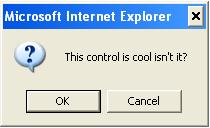
Introduction
ASP.NET 2.0 provides several server controls, but it still lacks a Message Box, Confirmation Box, etc. There is an excellent server control developed by Ning Liao, Liang Yang which you will get on CodeProject itself. But I guess it's not sufficient; you need to programmatically check everything in this model. So I developed this event driven server control which raises a GetMessageBoxRespose event on the button click of the client-side confirmation box. You can capture which button is pressed in this event. As the user presses the button, the page gets posted again and the state gets lost and whatever data we were processing needs to get back again. Hence, I made a provision to pass data while confirming, and we can get it back in the raised event. It's cool, isn't it?
Using the Code
To use the server control in your code, you need to add the server control as a .NET Framework Component to your web application. Right click the "Components" tab in the toolbox, click "Add/Remove Items," click "Browse", and select and add the server control MessageBox.dll from where you keep it in your computer. Then, drag and drop the server control to your web form. The following is the Default.aspx code with the server control included:
//First register Assembly with following line,
// If you drag drop control it will be done automatically.
<%@ Register Assembly="MessageBox"
Namespace="Utilities" TagPrefix="cc2" %>
//Add message box control
<cc2:MessageBox ID="msgBox" runat="server"
Style="z-index: 101; left: 0px; position: absolute; top: 0px"
Width="112px"
OnGetMessageBoxResponse="msgBox_GetMessageBoxResponse" />
To display the confirmation box, just call the Confirm method of the msgBox object, as shown below:
private void Page_Load(object sender, System.EventArgs e)
{
if( !IsPostBack )
{
msgBox.Confirm("This control is cool isn't it?", "Test Data");
}
else
{
msgBox.Alert("Page posback happened.");
}
}
When the user responds to the confirmation box by clicking either the "OK" or the "Cancel" button, the web page will be posted back. After postback, the MessageBox control will raise the GetMessageBoxResponse event, so you need to capture this event by registering its event handler. In this event, you will get which button is pressed by the user and other data, if passed, with the Confirm method:
private void msgBox_GetMessageBoxResponse(object sender,
Utilities.MessageBox.MessageBoxEventHandler e)
{
if( e.ButtonPressed ==
Utilities.MessageBox.MessageBoxEventHandler.Button.Ok )
{
lblMsg.Text = "You said ok. Thanks!!!";
}
else if (e.ButtonPressed ==
Utilities.MessageBox.MessageBoxEventHandler.Button.Cancel)
{
lblMsg.Text = "You said cancel. :(";
}
if (e.Data != null)
{
Response.Write(e.Data);
}
}
About the MessageBox Control
The basic mechanism of the MessageBox server control is actually very simple. As it is totally event-driven, the convenience it brings is tremendous. Use the Confirm method for confirmation and catch the GetMessageBoxResponse event. Get which button is pressed by the user and other data if passed with the Confirm method. I appreciate the work of Ning Liao, Liang Yang; these guys have done a great job, but I guess this is an improvement over their work, isn't it?
Source Code
namespace Utilities
{
[ToolboxData("<{0}:MessageBox runat="\""server\"></{0}:MessageBox>")]
[System.Serializable(), DesignTimeVisible()]
public class MessageBox : System.Web.UI.WebControls.WebControl
{
private string m_Session = "msgSession";
public class MessageBoxEventHandler : System.EventArgs
{
public enum Button
{
Ok, Cancel, NotPressed
}
public readonly MessageBoxEventHandler.Button ButtonPressed;
public readonly object Data;
public MessageBoxEventHandler(
MessageBoxEventHandler.Button buttonPressed)
: this(buttonPressed, null)
{
}
public MessageBoxEventHandler(MessageBoxEventHandler.Button
buttonPressed, object data)
{
this.ButtonPressed = buttonPressed;
this.Data = data;
}
}
public delegate void Message(object sender,
MessageBoxEventHandler e);
public event Message GetMessageBoxResponse;
private string content;
private const string ok = "ok";
private const string cancel = "cancel";
private const string notPressed = "notPressed";
public void Alert(string message)
{
string msg = message.Replace("\n", "\\n");
msg = message.Replace("\"", "'");
StringBuilder sb = new StringBuilder(50);
sb.Append(@"<script language="'javascript'">");
sb.Append(@"alert( """ + msg + @""" );");
sb.Append(@"</script>");
content = sb.ToString();
}
public void Confirm(string message)
{
this.Confirm(message, null);
}
public void Confirm(string message, object data)
{
string msg = message.Replace("\n", "\\n");
msg = message.Replace("\"", "'");
StringBuilder sb = new StringBuilder(100);
sb.AppendFormat(@"<input type='hidden' value='{0}' name='"
+ HiddenFieldName + "' />", MessageBox.notPressed);
sb.Append(
@"<script language="'javascript'" type='text/javascript'>");
sb.Append(@" if(confirm( """ + msg + @""" ))");
sb.Append(@" { ");
sb.Append("document.forms[0]." + HiddenFieldName +
".value='" + MessageBox.ok + "';" +
"document.forms[0].submit(); }");
sb.Append(@" else { ");
sb.Append("document.forms[0]." + HiddenFieldName +
".value='" + MessageBox.cancel +
"'; document.forms[0].submit(); }");
sb.Append(@"</script>");
content = sb.ToString();
if (data != null)
{
this.Page.Session[m_Session + this.ClientID] = data;
}
}
private string HiddenFieldName
{
get
{
return "hidF" + this.ID;
}
}
protected override void OnLoad(EventArgs e)
{
object data = null;
switch (this.Page.Request.Form[HiddenFieldName])
{
case MessageBox.ok:
this.Page.Request.Form[HiddenFieldName].Replace(
MessageBox.ok, MessageBox.notPressed);
if (this.Page.Session[m_Session + this.ClientID] != null)
{
data = this.Page.Session[m_Session + this.ClientID];
this.Page.Session.Remove(m_Session + this.ClientID);
}
OnMessageBoxShow(new MessageBoxEventHandler(
MessageBoxEventHandler.Button.Ok, data));
break;
case MessageBox.cancel:
this.Page.Request.Form[HiddenFieldName].Replace(
MessageBox.cancel, MessageBox.notPressed);
if (this.Page.Session[m_Session + this.ClientID] != null)
{
data = this.Page.Session[m_Session + this.ClientID];
this.Page.Session.Remove(m_Session + this.ClientID);
}
OnMessageBoxShow(new MessageBoxEventHandler(
MessageBoxEventHandler.Button.Cancel, data));
break;
case MessageBox.notPressed:
break;
default:
break;
}
base.OnLoad(e);
}
protected virtual void OnMessageBoxShow(MessageBoxEventHandler e)
{
if (GetMessageBoxResponse != null)
{
GetMessageBoxResponse(this, e);
}
}
protected override void Render(HtmlTextWriter output)
{
if (!this.DesignMode)
{
output.Write(this.content);
}
else
{
System.Web.UI.WebControls.Label lbl = new Label();
lbl.Font.Bold = this.Font.Bold;
lbl.Font.Italic = this.Font.Italic;
lbl.Font.Names = this.Font.Names;
lbl.Font.Overline = this.Font.Overline;
lbl.Font.Size = this.Font.Size;
lbl.Font.Strikeout = this.Font.Strikeout;
lbl.Font.Underline = this.Font.Underline;
lbl.ForeColor = this.ForeColor;
lbl.BackColor = this.BackColor;
lbl.BorderColor = this.BorderColor;
lbl.BorderStyle = this.BorderStyle;
lbl.BorderWidth = this.BorderWidth;
lbl.Text = this.ID;
lbl.RenderControl(output);
}
}
}
}
